ARCHIVED - Immigration and Refugee Board of Canada
 This page has been archived.
This page has been archived.
Archived Content
Information identified as archived on the Web is for reference, research or recordkeeping purposes. It has not been altered or updated after the date of archiving. Web pages that are archived on the Web are not subject to the Government of Canada Web Standards. As per the Communications Policy of the Government of Canada, you can request alternate formats on the "Contact Us" page.
2007-08
Departmental Performance Report
Immigration and Refugee Board of Canada
The original version was signed by
The Honourable Jason Kenney
Minister of Citizenship, Immigration and Multiculturalism
Section 1: Overview
Section 2: Analysis of Program Activities by Strategic Outcome
Section 3: Supplementary Information
Section 4: Other Items of Interest
Section 1: Overview
Chairperson's Message

I am pleased to present the 2007-2008 Performance Report for the Immigration and Refugee Board of Canada (IRB). This report is a comprehensive review of the IRB's performance and accomplishments as set against the stated plans and priorities for 2007-2008.
The IRB is an independent administrative tribunal with unique and important responsibilities within Canada's immigration, refugee determination and administrative justice systems. The IRB deals with cases ranging from admissibility hearings and immigration appeals to refugee status determinations and detention reviews. Through its work on behalf of Canadians, the IRB contributes directly to Canada's humanitarian traditions and the security of the Canadian public.
The Board underwent considerable transition over the past year. In addition to turnover in senior management and decision-maker ranks, the caseload in all three divisions, namely the Refugee Protection Division (RPD), the Immigration Appeal Division (IAD) and the Immigration Division (ID), has continued to increase. Combined with a continuing shortfall in the complement of Governor-in-Council (GIC) decision-makers in the RPD and IAD, this has resulted in a growing pending inventory and average case processing time for both divisions.
Revised selection process for GIC decision-makers
The IRB worked with other Government of Canada officials during the reporting period to establish a revised selection process for GIC decision-makers. The new process builds on the merit-based system already in place, enhancing transparency and ensuring that only candidates meeting the Board's rigorous selection criteria are recommended for appointment. During the period covered by this report, the Selection Advisory Board reviewed the applications of hundreds of candidates seeking appointment and identified qualified candidates for consideration by the Minister of Citizenship and Immigration.
Building a stronger, more flexible organization
In line with a commitment made in the 2007-2008 Report on Plans and Priorities, the IRB launched a review of its governance framework, with the aim of optimizing its organizational design and clarifying accountabilities among its senior management positions. Recommendations arising from the review will be prioritized and acted on in the 2008-2009 reporting period.
The Board also took steps throughout the year to strengthen its operational and leadership capacity, its diversity and its flexibility. To promote ethical behaviour by decision-makers, the IRB updated its code of conduct for decision-makers following an extensive consultation process. The new code, which for the first time in the Board's history applies to both GIC and public service decision-makers, was implemented in early 2008-2009.
The IRB launched a review of its core management controls in alignment with the Government of Canada's approach to management accountability. In addition, the first element in a multi-year employment equity strategy was rolled out, involving the establishment of a mentoring program for employees who are members of designated groups.
Transforming the way we work
The IRB achieved concrete gains during the reporting period through the continued pursuit of tribunal integration and internal process improvements. Steps forward in 2007-2008 included the implementation of a new adjudicative support structure for the three divisions. This has resulted in public service employees playing an expanded role in streaming and hearing readiness efforts and in case resolution, allowing decision-makers to devote more time to their unique adjudicative functions. By adopting innovative case management and adjudicative strategies, as well as through the dedication, flexibility and hard work of our decision-makers and staff, we have improved productivity across the divisions, without compromising fairness.
Delivering results for Canadians
The Board experienced an increased workload across its three divisions in 2007-2008. Growth was particularly strong in the RPD, where the number of finalizations was lower than anticipated during the reporting period as a consequence of the lower than expected decision-maker complement. Meanwhile, projections were exceeded in both the ID and IAD, with the IAD in particular finalizing the highest number of appeals in the Board's history. As in previous years, the proportion of IRB decisions set aside by the Federal Court remained very low: less than one percent of decisions were sent back to the Board to be reheard.
The challenges ahead
With the support of the Minister and the Government, the pace of appointments and reappointments of GIC decision-makers has quickened, although the Board was still short 58 decision-makers at the end of March 2008. Significant resources will be required to address the accumulated backlog of cases. However, the commitment of the IRB's personnel and the efficiency of its operations will help to ensure our success in doing so. At the same time, we will continue to pursue key initiatives in a number of areas, including our transformation agenda, allowing us to achieve even better results for Canadians in 2008-2009.
Brian Goodman
Chairperson
Management Representation Statement
I submit for tabling in Parliament the 2007-2008 Performance Report for the Immigration and Refugee Board of Canada.
This document has been prepared based on the reporting principles contained in the Guide to the Preparation of Part III of the 2007-2008 Estimates: Reports on Plans and Priorities and Departmental Performance Reports:
- It adheres to the specific reporting requirements outlined in the Treasury Board Secretariat guidance;
- It is based on the IRB's Strategic Outcome and Program Activity Architecture that were approved by the Treasury Board;
- It presents consistent, comprehensive, balanced and reliable information;
- It provides a basis of accountability for the results achieved with the resources and authorities entrusted to it; and
- It reports finances based on approved numbers from the Estimates and the Public Accounts of Canada.
Brian Goodman
Chairperson
Summary Information
Reason for existence
Who we are
The Immigration and Refugee Board of Canada (IRB) is an independent administrative tribunal that reports to the Parliament of Canada through the Minister of Citizenship and Immigration Canada (CIC).
As an organization responsible for applying administrative justice, the IRB adheres to the principles of natural justice, and its decisions are rendered in accordance with the law, including the Canadian Charter of Rights and Freedoms. This mandate is reflected in our mission, vision and values, which help shape our corporate priorities and identify the qualities we strive to embody. It also guides our day-to-day decisions and ensures that everyone and their work at the IRB are aligned with our mission and our vision for the future.
Table 1.1: The IRB's Mission, Vision and Values
| MISSION | |
| The Immigration and Refugee Board of Canada is an independent tribunal established by the Parliament of Canada. Our mission, on behalf of Canadians, is to make well-reasoned decisions on immigration and refugee matters, efficiently, fairly and in accordance with the law | |
| VISION | VALUES |
| We will excel in everything we do and will deal simply, quickly and fairly with everyone. Through innovation and flexibility, we will be a leading-edge administrative tribunal and a creative partner in building the future of the Canadian immigration system |
|
As Canada's largest federal tribunal, the IRB consists of three divisions, each with its own mandate under the Immigration and Refugee Protection Act (IRPA).
- Refugee Protection Division (RPD)
- Immigration Division (ID)
- Immigration Appeal Division (IAD)
The IRB employs approximately 928 people in its national headquarters office and regional offices. Through each division, the IRB delivers a simpler and faster form of justice than that provided by the courts, but with no less attentiveness to the rigour of the law. The IRB is a human rights tribunal, and the men and women who work at the Board respect the human dignity of all those who come before it.
The IRB is fully committed to applying fairness to all aspects of its work, which in turn means being just, lawful, honest, open and acting without bias. This includes recognizing that some individuals who appear before our Board have experienced very difficult circumstances, and respecting the diversity of cultures of individuals who appear before the IRB. Most importantly, it means recognizing that the determination of each case directly and profoundly affects people's lives.
Benefits to Canadians
Immigrants and refugees have always made significant contributions to Canada's growth and development. In the delivery of its mandate, the IRB benefits Canadians in three important ways:
- Its hearings on refugee claims ensure that Canada accepts those in need of protection in accordance with international obligations;
- Its hearings on admissibility and detention reviews help ensure the security of Canadians; and
- Its independent mechanism for resolving sponsorship, removal order and permanent residence status appeals ensures fairness of process for appellants and their families.
Through the decisions it makes, the IRB also contributes more broadly to the quality of life of Canada's communities by strengthening our country's social fabric, and by reflecting and reinforcing core values that are important to Canadians. These include respect for:
- Human rights
- Equality
- Fairness
- Peace
- Rule of law
What we do
Based on the Program Activity Architecture (PAA), the work of the IRB and its divisions is conducted through four program activities; the first three are responsible for all the tribunal decisions made at the Board.
Table 1.2: The IRB Division Mandates
| Refugee Protection Division (RPD) Program Activity |
|
| Admissibility Hearings and Detention Reviews Program Activity |
|
| Immigration Appeal Division (IAD) Program Activity |
|
| Corporate Management and Services Program Activity |
|
IRB Logic Model
What we do, what we produce and the impact of these activities are captured in the following diagram. It represents a dynamic process in which information is shared throughout the IRB to ensure that everyone in the organization is focused on the appropriate activities and outputs in order to achieve the expected results and benefits for Canadians.
Figure 1.1: The IRB Logic Model
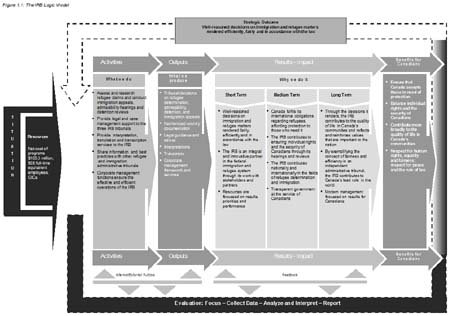
(Click on image to enlarge)
Summary Table
The following table highlights the IRB single strategic outcome, as well as the financial and human resources managed by the IRB during the reporting period. It also summarizes the four strategic priorities that have been developed and realized by the Board in order to achieve this outcome in 2007-2008.
Table 1.3: IRB Summary Table
| Strategic Outcome | ||
| Single Strategic Outcome (Based on legislated mandate) | ||
| Provide Canadians with well-reasoned decisions on immigration and refugee matters efficiently, fairly and in accordance with the law | ||
| Financial Resources | ||
| 2007-2008 ($ millions) | ||
| Planned Spending | Total Authorities | Actual Spending |
| 113.7 | 118.3 | 103.3 |
| Human Resources | ||
| 2007-2008 (Full-time Equivalents) | ||
| Planned | Actual | Difference |
| 1,025 | 928 | (97) |
| Strategic Priorities | ||
| 2007-2008 Strategic Priorities | ||
| Name | Type | Performance Status |
| 1. Consolidate the integration of the work of the Board's divisions to ensure quality, consistency and fairness in the efficient resolution of cases in a time of transition | Ongoing | Successfully met |
| 2. Continue to build an organization that strengthens its operational and leadership capacity, its diversity and its flexibility | Ongoing | Successfully met |
| 3. Continue to improve adjudicative and case management strategies including the implementation of Stage 1 of the Integrated Case Management System (ICMS) | Ongoing | Successfully met |
| 4. Implement a horizontal and fully integrated management plan that reflects the IRB's current reality | Ongoing | Successfully met |
Program Activities by Strategic Outcome
The IRB's four program activities were successfully carried out with the goal of achieving the Board's strategic priorities and outcome. The following table outlines the financial resources that were planned and actually spent for each activity and their linked contributions to the priorities described earlier.
Table 1.4: IRB Program Activities by Strategic Outcome
| Program Activities by Strategic Outcome | ||||
| 2007-2008 ($ millions) |
||||
| Expected Results | Performance Status | Planned Spending | Actual Spending | Contribute to the Following Priority |
| Strategic Outcome: Provide Canadians with well-reasoned decisions on immigration and refugee matters efficiently, fairly and in accordance with the law | ||||
|
Refugee Protection Program Activity Quality decisions rendered and cases resolved in a timely manner regarding refugee protection claims made in Canada |
Successfully met | 85.5 | 75.4 | Priority 1, 2 and 3 |
|
Admissibility Hearings and Detention Reviews Program Activity Quality decisions rendered and cases resolved in a timely manner regarding admissibility hearings and detention reviews |
Successfully met | 15.2 | 12.7 | Priority 1, 2 and 3 |
|
Immigration Appeal Program Activity Quality decisions rendered and cases resolved in a timely manner regarding immigration appeals |
Successfully met | 13.0 | 15.2 | Priority 1, 2 and 3 |
| Corporate Management and Services Program Activity | Successfully met | Note 1 | Note 2 | Priority 1, 2, 3 and 4 |
Note 1: The total Corporate Management and Services planned spending was $24.9 M (or 22% of planned spending) and included $14.5 M for personnel, $2.7 M for the Employee Benefit Plan (EBP) and $7.7 M for other operating expenditures. The amount of $24.9 M was proportionally reallocated to the other program activities: $18.7 M to Refugee Protection, $3.3 M to Admissibility Hearings and Detention Reviews and $2.9 M to Immigration Appeal. The reallocation was based on respective budget expenditures trends.
Note 2: The limited number of GIC decision-makers available reduced operating and salary expenditures in two core program activities. This created an opportunity to improve corporate management services and practices. The total Corporate Management and Services actual spending was $29.0 M (or 28% of actual spending) and included $17.4 M for personnel, $2.9 M for the Employee Benefit Plan (EBP) and $8.7 M for other operating expenditures. The amount of $29.0 M was proportionally reallocated to the three main program activities: $21.8 M to Refugee Protection, $3.9 M to Admissibility Hearings and Detention Reviews and $3.3 M to Immigration Appeal. The reallocation was based on respective budget expenditures trends.
Performance Summary
Overall, the IRB accomplished its mission during 2007-2008. All major program activities delivered the results that had been set and expected. Canadians were provided with well-reasoned decisions on immigration and refugee matters, efficiently, fairly and in accordance with the law. Alternative ways to resolve cases more efficiently were also introduced. Thousands of individuals who satisfied the legal requirements for protection in Canada were granted safe haven. Admissibility hearings, detention reviews and removal order appeal hearings enhanced the safety and security of Canadian communities. The resolution of sponsorship appeals provided certainty for appellants and their families, and enriched Canada's social and cultural fabric.
Although the objectives were all successfully met, the IRB faced a number of significant challenges in doing so. Numerous refugee claims and immigration appeals could not be heard or decided upon in a timely manner because of the shortfall of Governor in Council (GIC) appointed decision-makers and an increasing caseload. The IRB has responded to this situation by supporting the work of the Selection Advisory Board and identifying qualified GIC candidates for the Minister's consideration. The IRB also pursued its integration agenda and made several internal process improvements, which resulted in increased productivity. However, even with these greater efficiencies, the pending inventory continued to increase for a second consecutive year.
Operating Environment
During 2007-2008, the IRB carried out its mandate within a complex and ever-changing environment. Both international and domestic factors continue to influence the IRB's operating environment and context. For example, conflicts and country conditions abroad can result in refugee movements, which in turn affect the number of refugee protection claims made in Canada. The same is true of unanticipated shifts in international migration patterns, which can affect the number of people seeking admission to Canada.
Refugee populations
The 2007 Global Trends report, published by the United Nations High Commissioner for Refugees (UNHCR), shows that the steady decline in refugee numbers witnessed since 2002 was reversed in 2006 when numbers started increasing again. By the end of 2006, there were an estimated 9.9 million refugees. One year later, the global figure of refugees stood at 11.4 million, including 1.7 million people considered by UNHCR to be in a refugee-like situation.
In Canada, the increase in refugee protection claims seen in 2006 continued into the 2007-2008 reporting period, with Mexico, Colombia and Haiti representing the top source countries for refugee protection claims. The Americas accounted for well over half of all claims referred and Mexico continued to comprise an increasing portion of all IRB referrals at nearly 25 percent.
Figure 1.2: Refugee Claims Filed (2003-2007)
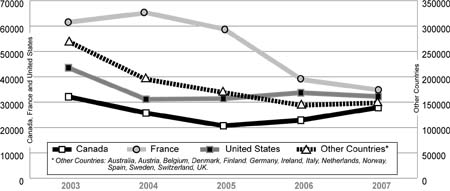
(Click on image to enlarge)
Changing workloads
Responding to the increased number of refugee protection claims and immigration appeals, the IRB has been increasing its emphasis on an integrated approach to the management and processing of all of its cases. At the same time, the refugee caseload is becoming more complex, driven by mixed migration, broader grounds for protection, security concerns and fraudulent documentation.
Growing trend of family sponsorships
Immigration continues to be very important for Canada, as immigrants represent an increasing part of the population. Canada's population of immigrants is expected to reach between 7 and 9.3 million by 2017. In this context and given the Government of Canada's priority of promoting family reunification, family-class sponsorship applications have increased at Canadian visa posts around the world. As a result, the IRB will continue to experience a high number of family sponsorship appeals.
Safe third country agreement
The Safe Third Country Agreement has been in effect between the United States and Canada since the end of 2004. Under the agreement, refugee protection claimants who travel through the United States or Canada by land, with some exceptions, are required to make their claims in the country where they first arrived. The IRB has been closely monitoring the litigation surrounding this agreement as a change in the agreement or its legal status could have an impact on the number of refugee claims referred to the RPD as well as the distribution of those claims across the country.
Appointment of decisions-makers
Due to a series of transitions in government between 2004 and 2007, the IRB has experienced a decline in the rate at which GIC decision-makers are appointed and reappointed to the Board. The resulting shortfall in decision-makers has served as a major contributing factor to the growth of the pending inventory, to about 42,000 claims waiting and 9,600 appeals waiting as of the end of the reporting period.
The shortfall has affected overall productivity, increased average processing times and challenged the Board's ability to provide timely services in both official languages and meet its obligations under the Official Languages Act (OLA).
Accountability
Public interest in the IRB's work continues, along with a greater demand for accountability and transparency in government. In December 2006, the Government of Canada brought into force the Federal Accountability Act (FAA). As noted in the April 2006 Speech from the Throne, this Act changes the existing system of oversight and management by strengthening the rules and institutions that ensure transparency and accountability to Canadians. The IRB continues to respond to this demand by improving performance reporting and implementing modern management practices (e.g. risk management and core management controls). Furthermore, the IRB has been strengthening its management accountability in the areas identified by the Treasury Board Secretariat (TBS) Management Accountability Framework (MAF) Assessments.
Protocol addressing decision-maker conduct issues
The IRB was the first federal administrative tribunal to institute a formal process for addressing complaints about the conduct of decision-makers appointed to the IRB by the Governor in Council. Instituted in 1999, the Protocol Addressing Member Conduct Issues recognizes that high standards of conduct are required of public officials, such as IRB decision-makers, whose decisions profoundly affect people's lives.
In 2007-2008, 12 complaints were filed under the Protocol. Of these complaints, nine were found not to fall within the scope of the Protocol, one was founded, one was founded in part and one was unfounded. No appeals were filed.
Government-wide initiatives
During 2007-2008, the IRB continued to implement government-wide initiatives aimed at improving public sector management and management practices in order to enhance the organization's overall performance. Particular emphasis was placed on building infrastructure in the areas of management, human resources, information technology and communications. These initiatives will continue in fiscal year 2008-2009 with the full implementation of the Government of Canada's Management, Resources and Results Structure (MRRS) Policy and the development of procurement and assets management policies and directives. The IRB will also continue to modernize its HR management practices and implement further initiatives related to the renewal of the public service and employment equity. These measures support the IRB's efforts to build the requisite management and organizational capacity to sustain a high volume of resolutions and decisions by ensuring that the necessary infrastructure and best management practices are in place.
Portfolio management
As partners within the immigration and refugee portfolio, the IRB, CIC and the Canada Border Services Agency (CBSA) continued to collaborate on operational matters while respecting each other's distinct mandates and the IRB's independence (see Figure 1.3). The portfolio approach has created opportunities for effective communication and coordination. Relationships within the portfolio reflect strengthened efforts in this regard on issues relating to the overall management of the portfolio and take into account evolving case management initiatives designed to meet ongoing challenges.
The IRB, CIC and the CBSA have negotiated a trilateral Memorandum of Understanding (MOU) which will more clearly define their institutional relationships and reflect the current operational environment and priorities. The agreement was signed in April 2008. This MOU will build on the IRB and CIC Administrative Framework Agreement, which has been in place since December 1996 and which defined the administrative relationship between the two organizations.
Figure 1.3: The IRB, CIC and CBSA Portfolio
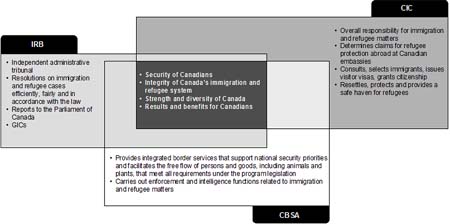
(Click on image to enlarge)
Partners and agencies
The IRB continued to work closely with the Minister's office and central agencies, including the Privy Council Office on GIC appointments of decision-makers and the TBS on program management and accountability. The IRB also worked with Public Works and Government Services Canada on procurement and accommodation issues and with the Public Service Commission, the Canada Public Service Agency and the Canada School of Public Service on human resources management issues. In addition, the IRB played a leading role in the organization of the 2008 annual conference of the Council of Canadian Administrative Tribunals (CCAT), with the Chairperson acting as conference co-chair. The CCAT annual conference provides an opportunity for tribunals across Canada to share best practices and new approaches to emerging issues in administrative justice.
Stakeholders
In an effort to enhance its interaction with stakeholders, the IRB reviewed how it coordinated its consultative activities. The introduction of a new consultative framework allowed the IRB to further improve its consultative mechanisms in order to better manage its relationships with stakeholders and facilitate the sharing of information between regional offices and headquarters.
The IRB's Consultative Committee on Practices and Procedures (CCPP) continued to provide the opportunity for regular contact between the IRB and non-governmental stakeholders. The CCPP provides a forum for consultation, advice, information-sharing and the discussion of issues of mutual concern regarding the Board's practices and procedures. The IRB proposed adjustments to the CCPP for a renewed focus on quality exchanges on issues of national concern. The Committee is composed of representatives from the Canadian Council for Refugees, the Canadian Bar Association, the Refugee Lawyers Association, the Quebec Immigration Lawyers Association, the Canadian Association of Professional Immigration Consultants and the UNHCR.
IRB regional offices maintained relationships with local stakeholders, including immigration consultants, bar associations, refugee and refugee law associations, UNHCR regional representatives and non-governmental organizations.
International context
The IRB has established an international reputation for expertise in refugee determination. Consistent with our mandate and resources, the IRB maintained an active international presence in three main areas:
- Participation in specialized multilateral fora: the IRB regularly participates in meetings of the International Association of Refugee Law Judges, the UNHCR Executive Committee and the Intergovernmental Consultations on Migration, Asylum and Refugees.
- Bilateral intergovernmental relations: the IRB exchanges information and best practices with a number of other refugee-receiving countries, including Austria, Australia, Costa Rica, Japan, the Netherlands, Sweden, the United Kingdom and the United States of America.
- Transfer of expertise/capacity-building partnerships: the IRB is involved in a multi-faceted partnership with the UNHCR whereby IRB personnel provide training and guidance on refugee status determination to UNHCR field staff. Discussions are also taking place on the possibility of expanding this partnership to capacity-building initiatives involving nascent national refugee authorities.
Link to Government of Canada outcome areas
Canada's federal organizations play an important role in contributing to the quality of life of Canadians. All government policies, outcomes, departmental mandates and programs are directed at fulfilling this role. The IRB makes important contributions to the Government of Canada's outcome areas, which are presented in the following diagram.
Table 1.5: IRB Program Activity Links to Government of Canada Outcome Areas
| CONTRIBUTING TO THE QUALITY OF LIFE OF CANADIANS |
| IRB Strategic Outcome Provide Canadians with well-reasoned decisions on immigration and refugee matters efficiently, fairly and in accordance with the law |
| Government of Canada Outcome Areas |
|
International A Safe and Secure World through International Cooperation |
|
|
Social Safe and Secure Communities |
|
|
Social A Diverse Society that Promotes Linguistic Duality and Social Inclusion |
|
|
* Through its removal orders work, the Immigration Appeal Program Activity also contributes to the Safe and Secure Communities outcome area.
|
Section 2: Analysis of Program Activities by Strategic Outcome
This section provides performance information on the IRB's plans, expected results and financial and human resources presented in its 2007-2008 Report on Plans and Priorities (RPP). Using the IRB's PAA and MRRS that were approved by TBS for the 2007-2008 reporting period, the section details the achievement of the Board's strategic priorities and strategic outcome.
Table 2.1: The IRB Program Activity Architecture
The 2007-2008 IRB Performance Report is the second time that the IRB uses the complete performance measurement framework to report on its strategic priorities and outcome. The investment in developing the framework and populating it with performance indicator data provides an improved foundation for this performance report. The IRB ensures it is focused on results, delivers value for money, is consistent with Government priorities, and continues to serve the purpose and mandate for which it was created.
Common Elements
The IRB has developed an Integrated Business Plan (IBP) for 2007-2008 that brings together the plans and expected results for its four program activities. The plan identifies both the common and distinct areas of activities for each program activity. Presented in this section are the performance results for the common elements and for each of the decision-making program activities. The performance results for the Corporate Management and Services program activity are presented in Section 4.
Table 2.2: Common Elements Plans and Results
|
Common Elements: Plans and Results for 2007-2008 |
|
| Strategic Outcome: Provide Canadians with well-reasoned decisions on immigration and refugee matters efficiently, fairly and in accordance with the law | |
|
Strategic Priority 1 Consolidate the integration of the work of the Board's divisions to ensure quality, consistency and fairness in the efficient resolution of cases in a time of transition |
|
| Plans | Results |
| Policy Instruments and Procedures | |
| Elaboration of IRB detention/security framework and implementation of selected elements across the divisions |
|
| Initiate the development of a common/shared policy on the use of videoconferencing and new technology |
|
| Develop and implement IRB policy governing conduct of representatives |
|
| Case Management Strategies | |
| Implement integrated adjudicative support model |
|
Cross-divisional integration initiatives:
|
|
| Performance Measures | |
| Continue to develop and refine a standardized approach to present IRB divisional reports, including meaningful cross-divisional indicators, both quantitative and qualitative |
|
|
Strategic Priority 2 Continue to build an organization that strengthens its operational and leadership capacity, its diversity and its flexibility |
|
| Plans | Results |
| Adjudicative Culture | |
| Pursue recruitment efforts of GICs for RPD and IAD |
|
| Review and deliver comprehensive new decision-maker training in light of anticipated renewal of workforce |
|
| Develop and implement comprehensive cross-divisional training program for RPD and IAD decision-makers and for tribunal officers (including joint training, where appropriate, among all divisions) |
|
Deliver focused and quality training on priority topics on an ongoing basis in order to meet the needs of decision-makers and to promote quality in handling of cases by staff and decision-makers:
|
|
| Action IAD-RPD deployment policy when decision-maker complement allows |
|
Distinct Program Activity Elements
The IRB's IBP also identifies the plans, expected results and operations that are unique to each IRB program activity and contribute to achieving the IRB's strategic priorities for 2007-2008 and the IRB's strategic outcome. These are highlighted in the following detailed analyses; the detailed analysis for Corporate Management and Services is presented in Section 4.
Refugee Protection Program Activity
| The Refugee Protection program activity receives the majority of IRB resources and is focused on rendering quality and timely decisions on inland refugee protection claims. To deliver on this mandate, the Refugee Protection program activity depends on experienced decision-makers and adjudicative support. |
Over the past year, the RPD continued to seek efficiencies while responding to the growing volume of refugee claims made on Canadian soil. Although expected demands were not fully realized due in part to a loss of decision-makers throughout the year, enhanced and effective adjudicative strategies and case management strategies enabled the RPD to meet its mandate while upholding its international reputation.
Ken Sandhu
Deputy Chairperson Refugee Protection Division |
Performance Measurements and Indicators
Table 2.3: Refugee Protection Program Activity Total Financial and Human Resources
| Financial Resources ($ millions) | ||
| Planned Spending | Total Authorities | Actual Spending |
| 85.5 | 84.7 | 75.4 |
| Human Resources (FTEs) | ||
| Planned | Actual | Difference |
| 815 | 697 | (118) |
Performance Highlights and Results
| During the reporting period, decision-maker productivity in the RPD has increased by an average of 8%, the highest in the last three years. New case management and adjudicative strategies enhanced overall efficiency. A bi-annual National Training Seminar that brought together decision-makers from across the country not only reinforced existing skills but also provided a venue to share experiences and gain knowledge from fellow experts in the refugee field. Although demands on the refugee determination system increased throughout the year, the quality of decision-making remained high. However, the number of new claims referred exceeded projections, thereby adding to the overall pending caseload. |
Table 2.4: Refugee Protection Program Activity Plans and Results
| Strategic Outcome: Provide Canadians with well-reasoned decisions on immigration and refugee matters efficiently, fairly and in accordance with the law | |
|
Strategic Priority 3 Continue to improve adjudicative and case management strategies including the implementation of Stage 1 of the Integrated Case Management System (ICMS) |
|
| Plans | Results |
| Distinct Elements and Tribunal Values | |
| Mitigate increasing pending inventory, processing times and cost per claim by monitoring and expanding the Fast Track initiative, and reducing adjournments and postponements, and through a more sophisticated streamlining |
|
| Further monitoring of RPD Action Plan in order to ensure implementation |
|
| Pursue measures to further streamline RPD processes |
|
| Continue to implement and monitor the strategic approach to quality adjudicative support and decision-making through quality issue sessions, discussion groups, additional National Documentation Packages, Jurisprudential Guides and Persuasive Decisions, as needed, and Guidelines for Vulnerable Persons |
|
| Launch ICMS Stage 1 for RPD |
|
Key Outputs
The outputs for the Refugee Protection program activity are:
- Claims referred
- Claims finalized
- Claims waiting
- Average processing time
- Average cost per claim finalized
Claims referred
Figure 2.1: Refugee Protection Claims Referred
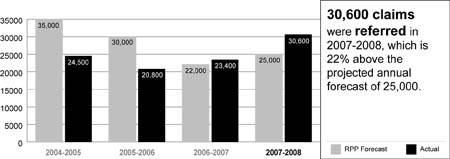
(Click on image to enlarge)
Note: The numbers have been rounded off to the nearest hundred.
The 2007-2008 referrals were 30% above the 2006-2007 totals and 46% above the 2005-2006 totals. Mexico remained the top source country for the fifth consecutive year, with 7,600 claims. Mexico claims accounted for 25% of all referrals. The 2007-2008 Mexican referrals were 37% more than the referrals in 2006-2007. Haiti claim referrals were 4,300, followed by Colombia as the third top source country, with 3,000 referrals. The Western hemisphere accounted for 60% of all claims referred in 2007-2008.
Claims finalized
Figure 2.2: Refugee Protection Claims Finalized
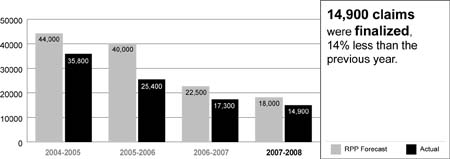
(Click on image to enlarge)
Note: The numbers have been rounded off to the nearest hundred.
Given the uncertainty surrounding the appointments and reappointments of decision-makers to the RPD, the IRB projected to finalize 16,000 to 20,000 refugee protection claims. In 2007-2008, the RPD finalized 14,900 claims.
During the reporting period, decision-makers' productivity was up 8% over last fiscal year. It was also the highest in three years and can be attributed to enhanced case management and adjudicative strategies. However, because fewer decision-makers were appointed and reappointed, the gains in productivity could not offset the shortfall in finalizations.
During 2007-2008, the RPD had an average of 79 decision-makers out of a funded complement of 127.
Claims waiting
Figure 2.3: Refugee Protection Claims Waiting
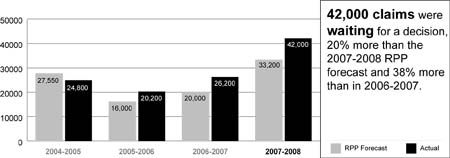
Note: The numbers have been rounded off to the nearest hundred.
Due to the increase in referrals and the drop in finalizations, on March 31, 2008, 42,000 claims were waiting for a decision versus the projected annual amount of 33,200. This is an increase of 16,000 claims waiting from the year before, and more than double from March 31, 2006.
Average processing time
The average processing time increased to 14 months in 2007-2008, versus the projected 12.5 months for the year. For the previous two fiscal years the average processing time was 12 months. The increased average processing time is due in part to a growing inventory and fewer experienced decision-makers. At year-end, close to 75% of claims finalized were older than a year, reflecting a rapidly growing, aging inventory and the RPD's decision to finalize the oldest claims in its inventory.
Average cost per claim finalized
The average cost per claim for 2007-2008 was $4,938, compared with $4,117 in 2006-2007. Unit costs per claim ranged from $2,200 for an expedited case to $7,300 for complex cases.
The increase in the average cost per claim is mainly attributable to a higher share of fixed business sustaining costs per unit caused by a lower volume of claims finalized during the year and increases in salary costs.
The actual cost per claim is slightly higher than the forecasted average cost of $4,700 (based on an estimate of 16,000 claim finalizations) as reported in the 2007-2008 Report on Plans and Priorities due to the factors noted above.
The cost per claim includes decision-making costs and costs of related activities such as case preparation, research, scheduling of hearings, legal services, foreign-language interpretation, technological support, translation services and administrative support. It also includes a share of the costs from the Corporate Management and Services program activity, which is allocated to the three decision-making program activities, based on expenditure trends.
Figure 2.4: Refugee Protection Master Graph
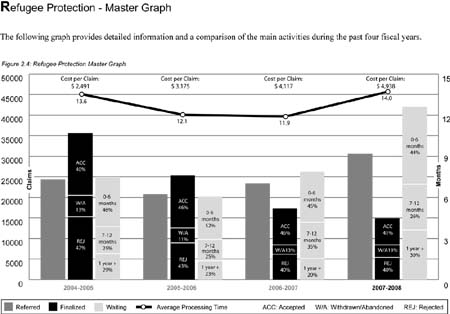
(Click on image to enlarge)
Admissibility Hearings and Detention Reviews Program Activity
| The Admissibility Hearings and Detention Reviews program activity holds hearings for foreign nationals or permanent residents who are alleged to be inadmissible to Canada pursuant to the provisions of the IRPA. Detention reviews are held concerning permanent residents and foreign nationals who are detained under the IRPA authority. Detainees must be seen by the Immigration Division within 48 hours and subsequent reviews must be conducted within specific timeframes as set out in the IRPA. Decision-makers must balance individuals' right to liberty with the security interests of Canadians and persons in Canada. |
Over the past 18 months, decision-maker turnover has reached 63% in the Central Region, and most decision-makers currently have one year or less of experience. Since the Central Region's workload represents approximately 60% of the Division's total workload, every effort has been made to support our new decision-makers, including the invaluable contributions of decision-makers and directors in the other regions. I am extremely proud of this remarkable example of teamwork.
Ghislaine Charlebois
Director General Immigration Division |
Performance Measurements and Indicators
Table 2.5: Admissibility Hearings and Detention Reviews Program Activity Total Financial and Human Resources
| Financial Resources ($ millions) | ||
| Planned Spending | Total Authorities | Actual Spending |
| 15.2 | 17.3 | 12.7 |
| Human Resources (FTEs) | ||
| Planned | Actual | Difference |
| 90 | 92 | 2 |
Performance Highlights and Results
| The level of activity is dependent on the number of cases referred by the CBSA. Over the course of 2007-2008, the admissibility and detention reviews program activity coped with an increase in referrals for both admissibility hearings (9%) and detention reviews (4%). The Immigration Division finalized 2,700 admissibility hearings in fiscal year 2007-2008, 17% more than the RPP forecast and 1% more than in the previous fiscal year. The Division finalized 16,050 detention reviews, 2% more than forecasted in the RPP and 2% more than finalized in 2006-2007. |
Table 2.6: Admissibility Hearings and Detention Reviews Program Activity Plans and Results
| Strategic Outcome: Provide Canadians with well-reasoned decisions on immigration and refugee matters efficiently, fairly and in accordance with the law | |
|
Strategic Priority 2 Continue to build an organization that strengthens its operational and leadership capacity, its diversity and its flexibility |
|
| Plans | Results |
| Distinct Elements and Tribunal Values | |
| Pursue succession recruitment efforts and integration of new decision-makers |
|
|
Strategic Priority 3 Continue to improve adjudicative and case management strategies including the implementation of Stage 1 of the Integrated Case Management System (ICMS) |
|
| Plans | Results |
| Distinct Elements and Tribunal Values | |
| Introduce and implement innovative approaches to processes by further developing and promoting tools that will support quality, consistency and efficiency in decision-making |
|
| Develop harmonized processes and adopt a more flexible resource management approach to help meet the legislative timeframes and operational requirements to achieve finalization of all cases referred to the Division in a timely fashion |
|
Key Outputs
The outputs for the Admissibility Hearings and Detention Reviews program activity are:
- Admissibility hearings finalized
- Detention reviews finalized
- Average cost per admissibility hearing finalized
- Average cost per detention review finalized
Admissiblity Hearings finalized
Figure 2.5: Admissibility Hearings Finalized
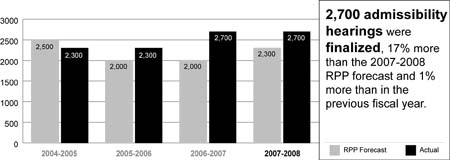
(Click on image to enlarge)
Note: The numbers have been rounded off to the nearest hundred.
Outcome of decisions
- 72% resulted in a removal order being issued because the person was determined inadmissible
- 3% resulted in permission to enter or to remain in Canada
- 7% were subject to the withdrawal of the inadmissibility allegation by the CBSA at the hearing
- 16% of persons who received a notice to appear at their hearing failed to appear and the case was closed
Detention Reviews finalized
Figure 2.6: Detention Reviews Finalized
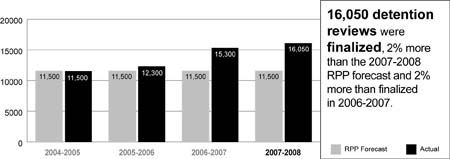
(Click on image to enlarge)
Note: Please note that starting in 2005-2006, the IRB included cases that were resolved before opening (RBOs) in its reporting on total finalizations. In 2005-2006, 10,950 detention reviews were finalized without RBO, 11,600 in 2006-2007 and 11,900 in 2007-2008. The numbers have been rounded off to the nearest hundred.
The ID received 16,200 requests for detention reviews from the CBSA in 2007-2008. The Division finalized 16,050 detention reviews; 2% more than forecasted in the 2007-2008 Report on Plans and Priorities and 2% more than finalized in 2006-2007. The remaining 150 cases were pending decisions.
The variance in the RPP forecast (11,500) and the actual number of detention reviews that were finalized (16,050) is attributable mainly to changes in the case management process. Cases resolved without a decision are now being included in the actual finalizations, as described below.
Of the 16,050 detention reviews finalized, 11,900 were finalized with a decision—a 2% increase over the 11,600 detention reviews finalized with a decision in 2006-2007. The remaining 4,150 were finalized without a decision either because the case was rescheduled or the person had been removed, released or detained by courts prior to a scheduled review.
Outcome of detention reviews finalized with a decision
- 74% resulted in continued detention
- 19% resulted in an offer to release, subject to certain terms and conditions
- 5% resulted in release orders without any terms or conditions attached
- 2% resulted in changes to the conditions imposed on persons granted release
Average cost per admissibility hearing and detention review finalized
The average cost per admissibility hearing finalized was $1,096 and the average cost per detention review finalized was $727. These costs are comparable to the actual average costs for 2006-2007 of $1,133 per admissibility hearing and $751 per detention review. As well, the average costs for 2007-2008 are in line with the forecasted cost indicated in the 2007-2008 Report on Plans and Priorities of $1,100 per admissibility hearing and $800 per detention review.
The cost per admissibility hearing and detention review includes decision-making costs and costs of related activities such as case preparation, research, scheduling of hearings, legal services, foreign-language interpretation, technological support, translation services and administrative support. It also includes a share of the costs from the Corporate Management and Services program activity, which is allocated to the three decision-making program activities, based on expenditure trends.
Figure 2.7: Admissibility Hearings Master Graph
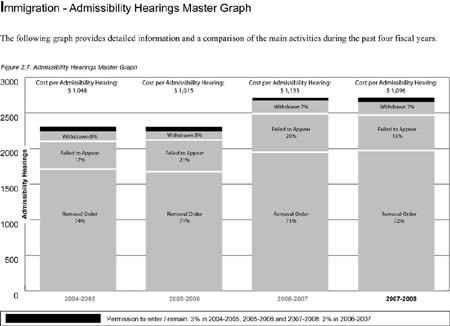
(Click on image to enlarge)
Figure 2.8: Detention Review Master Graph
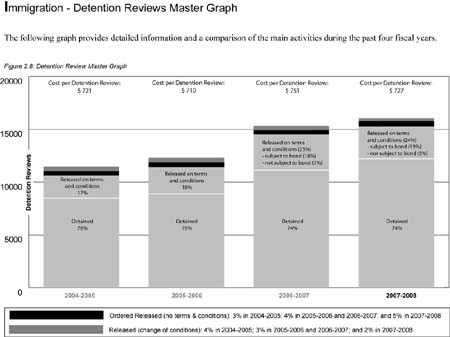
(Click on image to enlarge)
Immigration Appeal Program Activity
| The Immigration Appeal program activity hears immigration appeals from Canadian citizens and permanent residents whose applications to sponsor close family members to Canada have been refused. Other key functions include hearing appeals from permanent residents, foreign nationals with a permanent resident visa, protected persons who have been ordered removed from Canada and permanent residents outside of Canada who have not fulfilled their residency obligation. |
The Immigration Appeal Division achieved record-high productivity again in 2007-2008. I want to acknowledge the dedication and hard work of our decision-makers and public service employees. The quality of our work also remains high due to our ongoing professional development, implementation of our adjudication strategies and our comprehensive adjudicative support.
Shari Stein
A/Deputy Chairperson Immigration Appeal Division |
Performance Measurements and Indicators
Table 2.7: Immigration Appeal Program Activity Financial and Human Resources
| Financial Resources ($ millions) | ||
| Planned Spending | Total Authorities | Actual Spending |
| 13.0 | 16.3 | 15.2 |
| Human Resources (FTEs) | ||
| Planned | Actual | Difference |
| 120 | 139 | 19 |
The difference between planned and actual expenditures was mainly due to additionnal salaries and operating expenses in support of tribunal operations.
Performance Highlights and Results
| The IAD responded to continuing high caseload demands and decision-maker complement shortfalls with a year of record-high productivity. The momentum of the IAD Innovation transformation continued, with more improvements in case management and adjudicative support, further pilot projects and a major focus on conducting hearings in a more proactive manner. The challenge of the IAD Central Region backlog was addressed through an aggressive backlog reduction plan, including regional sharing of decision-makers from Eastern Region. This resulted in completing the oldest cases in our case inventory in Toronto. |
Table 2.8: Immigration Appeal Program Activity Plans and Results
| Strategic Outcome: Provide Canadians with well-reasoned decisions on immigration and refugee matters efficiently, fairly and in accordance with the law | |
|
Strategic Priority 3 Continue to improve adjudicative and case management strategies including the implementation of Stage 1 of the Integrated Case Management System (ICMS) |
|
| Plans | Results |
| Distinct Elements and Tribunal Values | |
| IAD Innovation – Continued implementation of IAD Innovation proposals to transform IAD into a more flexible and proactive division |
|
| Early Information Gathering and Early Informal Resolution – Obtain more information from both parties earlier, to support earlier screening, streaming and resolution |
|
| Alternative dispute resolution (ADR) – Finish transition of ADR program to public service, and increase early informal resolution through successful ADR by public service employees |
|
| Hearings – Ensure files are hearing-ready and have hearings conducted in a more proactive manner |
|
| Adjudication strategy and consistency – Develop and promote consistent and strategic approaches, including in areas such as removal order appeals and stays, proactive hearings, adjournments and postponements, and the applicant's testimony in marriage sponsorship appeals |
|
Key Outputs
The outputs for the Immigration Appeal program activity are:
- Appeals filed
- Appeals finalized
- Appeals waiting
- Average processing time
- Average cost per appeal finalized
Appeals filed
Figure 2.9: Immigration Appeals Filed
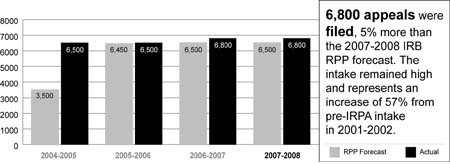
(Click on image to enlarge)
Note: The numbers have been rounded off to the nearest hundred.
The number of filed appeals remained high due to an increase in removal order appeals. Sponsorship appeals filed decreased only marginally by 1 percent from the previous fiscal year.
Appeals finalized
Figure 2.10: Immigration Appeals Finalized
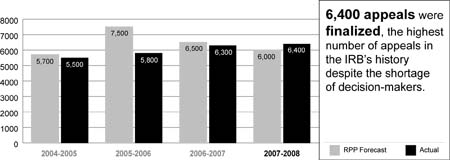
(Click on image to enlarge)
Note: The numbers have been rounded off to the nearest hundred.
Given the uncertainty surrounding the appointments and reappointments of decision-makers to the IAD, the IRB projected to finalize 5,800 to 6,300 appeals. A total of 6,400 appeals were finalized in 2007-2008, the highest number of appeals in the IRB's history.
Higher numbers of appeals were finalized despite the decrease in the decision-maker complement. The average decision-maker complement in 2007-2008 was 25, out of an authorized 37, the lowest since 2001-2002.
The IAD developed adjudication strategies to deal with its caseload and issues in a strategic and consistent manner. Several initiatives were implemented throughout 2007-2008 such as improved pre-hearing actions to ensure files are hearing ready and strategic sharing of decision-makers across the regions. The continued high productivity of decision-makers and the increase in public service support for the IAD contributed to an increased level of performance. The IAD focused on training decision-makers to conduct hearings in a more proactive manner. The large pending inventory in the Central Region was addressed through an aggressive backlog reduction initiative. One of several innovative measures and pilot projects was a new case stream for residency obligation appeals selected by the CBSA in which the Minister's counsel would not appear in person at the hearing but would instead provide written submissions. Successful use of the Alternative Dispute Resolution (ADR) program, the early review processes, and increased focus on the screening and streaming of cases were key mechanisms by which the IRB managed its immigration appeals caseload and which had a positive impact on productivity.
Outcome of decisions
Of the 6,400 appeals finalized in 2007-2008:
- 39% were allowed
- 31% were dismissed
- 30% were either withdrawn by the appellant or declared abandoned by the IRB
In addition to the appeals finalized, IAD decision-makers ordered 700 stays, a temporary outcome in a removal order appeal in which reconsideration and final decision is done at a later date.
These results have fluctuated slightly over the past few years, as outcomes are a function of the nature of the appeals being heard, with each case being decided independently on its particular merits.
Appeals waiting
Figure 2.11: Immigration Appeals Waiting
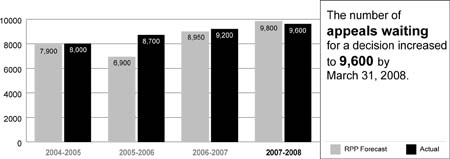
(Click on image to enlarge)
Note: The numbers have been rounded off to the nearest hundred.
The number of appeals waiting for a decision increased to 9,600 by March 31, 2008. (This includes 1,340 removal order appeals in which the removal order has been stayed and the appeal is waiting for reconsideration and a final decision later). The increased number of appeals waiting for a decision is a result of the number of appeals filed exceeding the number of appeals finalized for a fifth consecutive year.
Average processing time
The average processing time for appeals increased by 3% in 2007-2008 to 10.1 months nationally in comparison with 2006-2007. The average processing time has been increasing for the past four consecutive years. The increasing processing time is a result of the number of appeals filed exceeding the number of appeals finalized. Increased caseload and delays in decision-maker appointments and reappointments have been contributing factors to increased inventory levels and average processing time.
Average cost per appeal finalized
The overall average cost per finalized appeal for 2007-2008 of $2,330 is comparable to the 2006-2007 actual average cost of $2,260. Average unit costs per appeal were $2,200 for removal orders, $2,300 for sponsorship appeals and $2,500 for residency obligation appeals.
The overall average cost per finalized appeal is slightly higher than the forecasted cost of $2,200 as reported in the 2007-2008 Report on Plans and Priorities primarily due to increased salary costs.
The cost per appeal includes decision-making costs and costs of related activities such as case preparation, scheduling of hearings, legal services, foreign-language interpretation, technological support, translation services and administrative support. It also includes a share of the costs of the Corporate Management and Services program activity, which is allocated to the three decision-making program activities, based on expenditure trends.
Figure 2.12: Immigration Appeal Master Graph
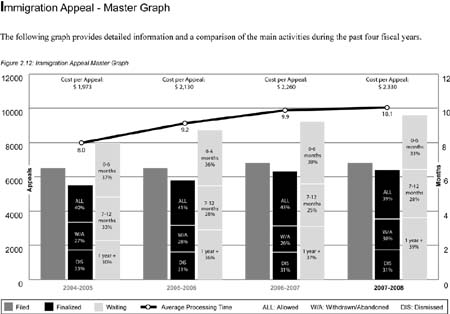
(Click on image to enlarge)
Section 3: Supplementary Information
Links to Government of Canada Outcomes
The following table shows the IRB's planned spending by program activity and alignment to the Government of Canada outcome areas.
Table 3.1: Departmental Link to the Government of Canada Outcomes
| Departmental Link to the Government of Canada Outcomes | ||||
| Strategic Outcome: Provide Canadians with well-reasoned decisions on immigration and refugee matters efficiently, fairly and in accordance with the law | ||||
| Program Activities | Actual Spending 2007-2008 ($ millions) |
Alignment to Government of Canada Outcome Area | ||
| Budgetary | Non-budgetary | Total | ||
| Refugee Protection | 75.4 | - | 75.4 | A safe and secure world through international cooperation |
| Admissibility Hearings and Detention Reviews | 12.7 | - | 12.7 | Safe and secure communities* |
| Immigration Appeal* | 15.2 | - | 15.2 | A vibrant Canadian culture and heritage |
* Through its removal orders work, the Immigration Appeal program activity also contributes to the Safe and Secure Communities outcome area.
The IRB contributes to the quality of life of Canadians by making important contributions to three Government of Canada outcomes areas.
Through the work of the Refugee Protection program activity, Canada accepts those in need of protection. Canada provides a safe haven to persons with a well-founded fear of persecution, as well as to those who face a danger of torture or risk to their life or risk of cruel and unusual treatment or punishment. This contributes to a safe and secure world environment through international cooperation.
Through the work of the Admissibility Hearings and Detention Reviews program activity, and through the removal order appeals work of the Immigration Appeal program activity, the IRB recognizes the consequences of the decisions it makes with respect to enhancing public safety and protecting Canadian citizens. It is with this sense of responsibility that the IRB maintains the balance between individual rights and the security of Canadians. This enhances the safety and security of Canadian communities.
Through the sponsorship appeals work of the Immigration Appeal program activity, the IRB recognizes the contributions of immigrants to the strength and vitality of Canadian society and culture, as well as the Government of Canada's commitment to family reunification. Canada is a country enriched by the many different origins of its population. This contributes to a vibrant Canadian culture and heritage.
Comparison of Planned to Actual Spending (incl. FTEs)
This table offers a comparison of the Main Estimates, Planned Spending, Total Authorities, Actual Spending for 2007-2008 and historical figures for Actual Spending.
Table 3.2: Comparison of Planned to Actual Spending (incl. FTEs)
| ($ millions) | 2005-2006 | 2006-2007 | 2007-2008 | |||
| Actual | Actual | Main Estimates | Planned Spending | Total Authorities | Actual | |
| Refugee Protection | 90.6 | 81.4 | 85.5 | 85.5 | 84.7 | 75.4 |
| Admissibility Hearings and Detention Reviews | 10.4 | 12.2 | 15.2 | 15.2 | 17.3 | 12.7 |
| Immigration Appeal | 11.7 | 16.8 | 13.0 | 13.0 | 16.3 | 15.2 |
| Total | 112.7 | 110.4 | 113.7 | 113.7 | 118.3 | 103.3 |
| Less: Non-respendable revenue | ||||||
| Plus: Cost of services received without charge | 20.3 | 19.5 | 19.2 | 18.4 | ||
| Total Departmental Spending | 133.0 | 129.9 | 132.9 | 121.7 | ||
| Full-time Equivalents (FTEs) | 1,035 | 942 | 1,025 | 928 | ||
The IRB's total authorities of $118.3 million increased by $4.6 million from its planned spending of $113.7 million due mainly to an additional amount of $4.6 million in funding carried-forward from 2006-2007.
Actual spending for 2007-2008 was $103.3 million, $15.0 million less than total authorities. Unused resources were attributable mainly to:
- A surplus of $7.6 million in various areas due to delays in appointments of decision-makers and staffing of public service positions
- A surplus of $7.4 million in the special purpose allotment for the translation of decisions due to a lower volume of translations than initially anticipated
Voted and Statutory Items
Table 3.3: Voted and Statutory Items
| 2007-2008 | |||||
|
Voted or Statutory Items ($ millions) |
Truncated Vote of Statutory Wording |
Main Estimates | Planned Spending | Total Authorities | Actual |
| 10 | Operating expenditures | 100.3 | 100.3 | 107.1 | 92.1 |
| (S) |
Contributions to employee benefit plans |
13.4 | 13.4 | 11.2 | 11.2 |
| Total | 113.7 | 113.7 | 118.3 | 103.3 | |
Integrated Case Management System (ICMS) Project
The implementation of the ICMS for the RPD supports the IRB in its efforts to improve case preparation and management by streamlining and automating business processes, and by providing all IRB employees with access to a national repository of information required to support quality decision-making.
The ICMS was implemented for the RPD on April 1, 2007. The ICMS project has closed and the structure for the maintenance of the system is in place. Throughout the first half of 2007-2008, the IRB trained staff and decision-makers to provide them with the knowledge and skills required for them to make effective use of the system. The IRB also ensured that sufficient knowledge transfer and organizational capacity was achieved to support and maintain ICMS as the primary system of record for the RPD.
Table 3.4: Integrated Case Management System (ICMS) Project
| Stage 1 | |
| Plans | Results |
| ICMS in production: National deployment of ICMS for the RPD |
|
| Facilitate effective change management in preparation for the transition to ICMS through comprehensive training, communications, and change management plans |
|
| Stage 2 | |
| Plans | Results |
| Automate IAD processes |
|
| Stage 3 | |
| Plans | Results |
| Automate ID processes |
|
Travel Policies
The IRB follows the TBS Travel Directive, Rates and Allowances and Special Travel Authorities.
Financial Statements
The following financial statements are prepared in accordance with accrual accounting principles. The unaudited supplementary information presented in the financial tables in the IRB Performance Report is prepared on a modified cash basis of accounting in order to be consistent with appropriation-based reporting. Note 3 of the financial statements reconciles these two accounting methods.
Statement of management responsibility
Responsibility for the integrity and objectivity of the accompanying financial statements for the year ended March 31, 2008, and all information contained in these statements rests with the management of the Immigration and Refugee Board of Canada (the IRB). These financial statements have been prepared by management in accordance with Treasury Board accounting policies, which are consistent with Canadian generally accepted accounting principles for the public sector.
Management is responsible for the integrity and objectivity of the information in these financial statements. Some information in the financial statements is based on management's best estimates and judgment and gives due consideration to materiality. To fulfil its accounting and reporting responsibilities, management maintains a set of accounts that provides a centralized record of the IRB's financial transactions. Financial information submitted to the Public Accounts of Canada and included in the IRB's Departmental Performance Report is consistent with these financial statements.
Management maintains a system of financial management and internal control designed to provide reasonable assurance that financial information is reliable, that assets are safeguarded and that transactions are in accordance with the Financial Administration Act, are executed in accordance with prescribed regulations, are within Parliamentary authorities, and are properly recorded to maintain accountability of Government funds. Management also seeks to ensure the objectivity and integrity of data in its financial statements by careful selection, training and development of qualified staff, by organizational arrangements that provide appropriate divisions of responsibility, and by communication programs aimed at ensuring that regulations, policies, standards and managerial authorities are understood throughout the IRB.
The Chairperson's Management Board (the CMB) is the senior management body responsible for setting organizational priorities and objectives and providing overall direction to the IRB. The CMB oversees major initiatives that cut across the organization to ensure a comprehensive and integrated approach.
Management is supported and assisted by an Audit and Evaluation Committee (the AEC), a sub-committee of the CMB. The primary role of the AEC is to provide functional guidance over internal audit and evaluation.
The Chief Financial Officer is a full member of both the CMB and AEC.
The financial statements of the IRB have not been audited.
| Brian Goodman Chairperson |
Serge Gascon, CGA Chief Financial Officer |
Ottawa, Canada
July 31, 2008
Statement of Operations (Unaudited) For the Year Ended March 31
(in thousands of dollars)
| 2008 | 2007 | ||||
| Refugee Protection | Immigration Appeal | Admissibility Hearings & Detention Reviews | Total | Total | |
| Operating Expenses | |||||
| Salaries and employee benefits | 60,863 | 11,767 | 9,426 | 82,056 | 85,835 |
| Rentals | 10,813 | 1,710 | 2,187 | 14,710 | 15,036 |
| Professional and special services | 9,590 | 2,833 | 1,839 | 14,262 | 15,955 |
| Amortization (Note 5) | 5,947 | 53 | 68 | 6,068 | 4,673 |
|
Transpor- tation and telecom munications |
3,132 | 626 | 517 | 4,275 | 4,558 |
|
Repair and mainte- nance |
1,824 | 193 | 581 | 2,598 | 1,259 |
| Acquisition of equipment (less than $10K) | 1,007 | 179 | 250 | 1,436 | 1,848 |
| Utilities, materials and supplies | 554 | 74 | 84 | 712 | 722 |
| Information | 174 | 8 | 16 | 198 | 227 |
| Other | 123 | 1 | 2 | 126 | 32 |
| Total Operating Expenses | 94,027 | 17,444 | 14,970 | 126,441 | 130,145 |
| Revenues | |||||
| Miscellaneous | 27 | 4 | 5 | 36 | 9 |
| Total Revenues | 27 | 4 | 5 | 36 | 9 |
| Net Cost of Operations | 94,000 | 17,440 | 14,965 | 126,405 | 130,136 |
The accompanying notes form an integral part of these financial statements.
Statement of Financial Position (Unaudited) at March 31
(in thousands of dollars)
| 2008 | 2007 | ||
| ASSETS | |||
| Financial assets | |||
| Accounts receivables and advances (Note 4) | 2,621 | 3,576 | |
| Non-financial assets | |||
| Prepaid expenses | 117 | 129 | |
| Tangible capital assets (Note 5) | 18,397 | 23,307 | |
| Total non-financial assets | 18,514 | 23,435 | |
| TOTAL | 21,135 | 27,011 | |
| LIABILITIES | |||
| Accounts payable and accrued liabilities (Note 6) | 8,102 | 9,723 | |
| Vacation pay and compensatory leave | 4,014 | 3,445 | |
| Employee severance benefits (Note 7b) | 15,104 | 15,239 | |
| Total liabilities | 27,220 | 28,407 | |
| EQUITY OF CANADA | (6,085) | (1,396) | |
| TOTAL | 21,135 | 27,011 | |
| Contingent liabilities (Note 8) | |||
The accompanying notes form an integral part of these financial statements.
Statement of Cash Flow (Unaudited) For the Year Ended March 31
(in thousands of dollars)
| 2008 | 2007 | |
| Operating activities | ||
|
Net cost of operations
|
126,405 | 130,136 |
|
Non-cash items:
|
||
|
Amortization of capital assets (Note 5)
|
(6,068) | (4,673) |
|
Services received without charge (Note 9a)
|
(18,370) | (19,524) |
|
Variations in Statement of Financial Position:
|
||
|
Increase (decrease) in accounts receivable and advances
|
(955) | 859 |
|
Increase (decrease) in prepaid expenses
|
(12) | 105 |
|
Decrease (increase) in liabilities
|
1,187 | (2,244) |
| Cash used by operating activities | 102,187 | 104,659 |
| Capital investment activities | ||
|
Acquisitions of tangible capital assets (Note 5)
|
1,158 | 5,182 |
| Cash used by capital investment activities | 1,158 | 5,182 |
| Financing activities | ||
|
Net cash provided by Government of Canada (Note 3c)
|
(103,345) | (109,841) |
The accompanying notes form an integral part of these financial statements.
Notes to the Financial Statements (Unaudited)
1. Authority and Objectives
Created by an Act of the Canadian Parliament in 1989, the IRB is the largest Canadian administrative tribunal performing quasi-judicial functions. Its mandate is contained in Part 4 of the Immigration and Refugee Protection Act (the IRPA).
As an independent tribunal, the IRB's mandate is to:
- determine claims for refugee protection made in Canada
- adjudicate admissibility hearings and review reasons for detention
- decide appeals from sponsorship refusals, certain removal orders and residency obligation decisions, and decide appeals by the Minister of Citizenship and Immigration from decisions made in admissibility hearings
As an organization with three administrative justice divisions, the IRB provides a responsive and efficient means of delivering administrative justice for individuals and ensures that all people who come before it are treated fairly. In fulfilling its mandate, the IRB contributes directly to maintaining public confidence in the integrity of Canada's immigration and refugee determination system.
2. Summary of Significant Accounting Policies
The financial statements have been prepared in accordance with Treasury Board accounting policies, which are consistent with Canadian generally accepted accounting principles for the public sector.
Significant accounting policies are as follows:
(a) Parliamentary Appropriations – The IRB is financed by the Government of Canada through Parliamentary appropriations. Appropriations provided to the IRB do not parallel financial reporting according to generally accepted accounting principles since appropriations are primarily based on cash flow requirements. Consequently, items recognized in the statement of operations and the statement of financial position are not necessarily the same as those provided through appropriations from Parliament. Note 3 provides a high-level reconciliation between the bases of reporting.
(b) Net Cash Provided by Government – The IRB operates within the Consolidated Revenue Fund (the CRF), which is administered by the Receiver General for Canada. All cash received by the IRB is deposited to the CRF and all cash disbursements made by the IRB are paid from the CRF. The net cash provided by Government is the difference between all cash receipts and all cash disbursements including transactions between departments of the federal government.
(c) Change in net position in the Consolidated Revenue Fund is the difference between the net cash provided by Government and appropriations used in a year, excluding the amount of non-respendable revenue recorded by the IRB. It results from timing differences between when a transaction affects appropriations and when it is processed through the CRF.
(d) Revenues – Revenues are accounted for in the period in which the underlying transaction or event occurred that gave rise to the revenues. The IRB does not charge for its services and its only revenues stem from gains on disposals of crown assets, Access to Information and Privacy fees and interest on overdue accounts receivable.
(e) Expenses - Expenses are recorded on an accrual basis:
- Vacation pay and compensatory leave are expensed as the benefits accrue to the employees under their respective terms of employment;
- Services provided without charge by other government departments for accommodation, the employer's contribution to the health and dental insurance plans and legal services are recorded as operating expenses at their estimated cost.
(f) Employee future benefits
- Pension benefits: Eligible employees participate in the Public Service Pension Plan, a multi-employer administered by the Government of Canada. The IRB contributions to the Plan are charged to expenses in the year they are incurred and represent the total obligation of the IRB to the Plan. Current legislation does not require the IRB to make contributions for any actuarial deficiencies of the Plan.
- Severance benefits: Employees are entitled to severance benefits under labour contracts or conditions of employment. These benefits are accrued as employees render the services necessary to earn them. The obligation relating to the benefits earned by employees is calculated using information derived from the results of the actuarially determined liability for employee severance benefits for the Government as a whole.
(g) Accounts receivables are stated at amounts expected to be ultimately realized. A provision can be made for external parties' receivables where recovery is considered uncertain.
(h) Contingent liabilities – Contingent liabilities are potential liabilities, which may become actual liabilities when one or more future events occur or fail to occur. To the extent that the future event is likely to occur or fail to occur, and a reasonable estimate of the loss can be made, an estimated liability is accrued and an expense recorded. If the likelihood is not determinable or an amount cannot be reasonably estimated, the contingency is disclosed in the notes to the financial statements.
(i) Tangible capital assets – All tangible capital assets having an initial cost of $10,000 or more are recorded at their acquisition cost. Amortization of tangible capital assets is done on a straight-line basis over the estimated useful life of the assets as follows:
| Asset class | Amortization Period |
| Informatics hardware | 4 years |
| Informatics software | 5 years |
(j) Measurement uncertainty – The preparation of these financial statements in accordance with Treasury Board accounting policies which are consistent with Canadian generally accepted accounting principles for the public sector requires management to make estimates and assumptions that affect the reported amounts of assets, liabilities, revenues and expenses reported in the financial statements. At the time of preparation of these statements, management believes the estimates and assumptions to be reasonable. The most significant items where estimates are used are the liability for employee severance benefits and the useful life of tangible capital assets. Actual results could significantly differ from those estimated. Management's estimates are reviewed periodically and, as adjustments become necessary, they are recorded in the financial statements in the year they become known.
3. Parliamentary Appropriations
The IRB receives its funding through annual Parliamentary appropriations. Items recognized in the statement of operations and the statement of financial position in one year may be funded through Parliamentary appropriations in prior, current or future years. Accordingly, the IRB has different net results of operations for the year on a government funding basis than on an accrual accounting basis. The differences are reconciled in the following tables:
(a) Reconciliation of net cost of operations to current year appropriations used:
| (in thousands of dollars) | 2008 | 2007 |
| Net cost of operations | 126,405 | 130,136 |
| Adjustments for items affecting net cost of operations but not affecting appropriations: | ||
| Add (Less): | ||
Services received without charge (Note 8) |
(18,370) | (19,524) |
Amortization of tangible capital assets |
(6,068) | (4,673) |
Vacation pay and compensatory leave |
(569) | 333 |
Adjustments to previous years accounts payable |
429 | 3 |
Employee severance benefits |
135 | (1,153) |
Refunds of previous year's expenditures |
78 | 49 |
Revenue not available for spending |
36 | 9 |
Accounts receivable set-up |
6 | - |
Prepaid expenses previously charged to appropriations |
5 | - |
Justice Canada's expenditures |
- | (29) |
| Adjustments for items affecting net cost of operations but not affecting appropriations: | ||
| Add (Less): | ||
Acquisition of capital assets |
1,158 | 5,182 |
Prepaid expenses |
5 | 105 |
| Current year appropriations used | 103,250 | 110,438 |
(b) Appropriations provided and used
| (in thousands of dollars) | 2008 | 2007 |
| Vote 10 - Operating expenditures | 100,186 | 103,259 |
| Vote 10a - Supplementary | 136 | 3,829 |
| Vote 10 - Transfer from Treasury Board Secretariat | 110 | - |
| Vote 15 - Transfer from Treasury Board Secretariat | 694 | 1,049 |
| Vote 22 - Transfer from Treasury Board Secretariat | 4,583 | - |
| Vote 23 - Transfer from Treasury Board Secretariat | 1,414 | - |
| Vote 35 - Transfer from Treasury Board Secretariat | (2) | - |
| Statutory amounts | 11,209 | 11,189 |
| Less: | ||
Lapsed appropriations: Operating |
(15,080) | (8,888) |
Current year appropriations used |
103,250 | 110,438 |
(c) Reconciliation of net cash provided by Government to current year appropriations used
| (in thousands of dollars) | 2008 | 2007 |
| Net cash provided by Government | 103,345 | 109,841 |
| Revenue not available for spending | 543 | 55 |
| 103,888 | 109,896 | |
| Change in net position in the Consolidated Revenue Fund | ||
Variation in accounts receivable and advances |
955 | (859) |
Variation in accounts payable and accrued liabilities |
(1,621) | 1,423 |
Other adjustments |
28 | (22) |
| (638) | 542 | |
| Current year appropriations used | 103,250 | 110,438 |
4. Accounts Receivable and Advances
The following table presents details of accounts receivable and advances:
| (in thousands of dollars) | 2008 | 2007 |
| Receivable from other Federal Government departments and agencies | 2,481 | 3,472 |
| Receivables from external parties | 128 | 100 |
| Employee advances | 12 | 4 |
| Total | 2,621 | 3,576 |
5. Tangible Capital Assets
Cost (in thousands of dollars)
| Capital asset class | Opening Balance | Acquisitions | Work in Progress Transfer | Closing balance |
| Informatics Hardware | 2,587 | 302 | - | 2,889 |
| Informatics Software | 17,425 | 21 | 12,790 | 30,236 |
| Software under development | 12,554 | 601 | (12,790) | 365 |
| Work in Progress | - | 234 | - | 234 |
| Total | 32,566 | 1,158 | - | 33,724 |
Accumulated amortization (in thousands of dollars)
| Capital asset class | Opening Balance | Amortization | Closing balance |
| Informatics Hardware | 1,968 | 281 | 2,249 |
| Informatics Software | 7,291 | 5,787 | 13,078 |
| Software under development | - | - | - |
| Work in Progress | - | - | - |
| Total | 9,259 | 6,068 | 15,327 |
| Capital asset class | 2008 Net book value | 2007 Net book value |
| Informatics Hardware | 640 | 619 |
| Informatics Software | 17,158 | 10,134 |
| Software under development | 365 | 12,554 |
| Work in Progress | 234 | - |
| Total | 18,397 | 23,307 |
Amortization expense for the year ended March 31, 2008, is $6,068 (2007 - $4,673).
6. Accounts Payable and accrued liabilities
The following table presents details of accounts payables and accrued liabilities:
| (in thousands of dollars) | 2008 | 2007 |
| Accounts payable external | 3,521 | 3,976 |
| Accounts payable other government departments and agencies | 1,405 | 1,308 |
| Accrued liabilities | 3,176 | 4,439 |
| Total | 8,102 | 9,723 |
7. Employee Benefits
(a) Pension Benefits: IRB employees participate in the Public Service Pension Plan, which is sponsored and administered by the Government of Canada. Pension benefits accrue up to a maximum period of 35 years at a rate of 2 percent per year of pensionable service, times the average of the best five consecutive years of earnings. The benefits are integrated with Canada/Québec Pension Plans benefits and they are indexed to inflation.
Both employees and the IRB contribute to the cost of the Plan. The 2007-08 expense amounts to $11,204,992 ($11,183,580 in 2006-2007), which represents approximately 2.1 times (2.2 in 2006-2007) the contributions by employees.
The IRB's responsibility with regard to the Plan is limited to its contributions. Actuarial surpluses or deficiencies are recognized in the financial statements of the Government of Canada, as the Plan's sponsor.
(b) Severance Benefits: The IRB provides severance benefits to its employees based on eligibility, years of service and final salary. These severance benefits are not pre-funded. Benefits will be paid from future appropriations. Information about the severance benefits, measured as at March 31, is as follows:
| (in thousands of dollars) | 2008 | 2007 |
| Accrued benefit obligation, beginning of the year | 15,239 | 14,086 |
| Cost for the year | 1,329 | 2,981 |
| Benefits paid during the year | (1,464) | (1,828) |
| Accrued benefit obligation, end of the year | 15,104 | 15,239 |
8. Contingent liabilities
Claims have been made against the IRB in the normal course of operations. Legal proceedings for claims totalling approximately $5,620,086 ($5,616,000 in 2007) were still pending at March 31, 2008. Some of these potential liabilities may become actual liabilities when one or more future events occur or fail to occur. To the extent that the future event is likely to occur or fail to occur, and a reasonable estimate of the loss can be made, an estimated liability is accrued and an expense recorded in the financial statements. No liability set-up was required because no future events were likely to occur.
9. Related party transactions
The IRB is related in terms of common ownership to all Government of Canada departments and agencies and Crown corporations. The IRB enters into transactions with these entities in the normal course of business and on normal trade terms. Also, during the year, the IRB received services, which were obtained without charge from other Government departments as presented in part (a) below.
(a) Services received without charge: During the year, the IRB received without charge from other departments, accommodation, legal fees and the employer's contribution to the health and dental insurance plans. These services without charge have been recognized in the IRB Statement of Operations as follows:
| (in thousands of dollars) | 2008 | 2007 |
| Accomodation | 13,729 | 13,986 |
| Employer's contribution to the health and dental insurance plans | 4,641 | 5,533 |
| Legal services | - | 3 |
| Total | 18,370 | 19,524 |
The Government has structured some of its administrative activities for efficiency and cost-effectiveness purposes so that one department performs these on behalf of all without charge. The costs of these services, which include payroll and cheque issuance services provided by Public Works and Government Services Canada, are not included as an expense in the IRB's Statement of Operations.
(b) Payables and receivables outstanding at year-end with related parties:
| (in thousands of dollars) | 2008 | 2007 |
| Accounts receivable from other government departments and agencies | 2,481 | 3,472 |
| Accounts payable to other government departments and agencies | 1,405 | 1,308 |
List of Electronic Tables
The following tables will be submitted electronically.
Table 3.5: Response to Parliamentary Committee and External Audits
For supplementary information on the IRB's response to Parliamentary Committees and External Audits please visit: http://www.tbs-sct.gc.ca/dpr-rmr/st-ts-eng.asp.
Table 3.6: Internal Audits and Evaluations
For supplementary information on the IRB's Internal Audits and Evaluations, please visit: http://www.tbs-sct.gc.ca/dpr-rmr/st-ts-eng.asp.
Section 4: Other Items of Interest
Corporate Management and Services Program Activity
As described previously in the TBS approved PAA, the Corporate Management and Services program activity provided support to the three IRB program activities through a range of management and oversight services, HR management, financial management, legal services, communications, procurement and assets management, information technology, information management, internal audit services and evaluation services. It also provided the IRB with efficient management processes and administrative services while promoting organizational effectiveness, and implemented various government-wide management and improvement initiatives. In addition, the Corporate Management and Services program activity ensured that all corporate management services are integrated into the business of the IRB.
As previously described in Section 1, the shortfall in the number of decision-makers reduced the operating and salary expenses in the Refugee Protection and Admissibility Hearings and Detention Reviews program activities. This created an opportunity to further improve management practices in the Corporate Management and Services program activity. As noted in its 2007-2008 RPP, the IRB was planning a number of initiatives and improvements in this program activity.
Performance Highlights
The Corporate Management and Services major activities were aligned with the strategic priorities set out for the organization. The following table summarizes the key performance results that were achieved.
Table 4.1: Corporate Management and Services Plans and Expected Results
| Strategic Outcome: Provide Canadians with well-reasoned decisions on immigration and refugee matters efficiently, fairly and in accordance with the law | |
|
Strategic Priority 1 Consolidate the integration of the work of the Board's divisions to ensure quality, consistency and fairness in the efficient resolution of cases in a time of transition |
|
| Plans | Results |
| Participate in and coordinate national and international events (including conferences) to showcase the IRB's integration efforts and position the IRB as a leader in the administrative justice community in Canada and in the refugee and immigration sector internationally |
|
|
Strategic Priority 2 Continue to build an organization that strengthens its operational and leadership capacity, its diversity and its flexibility |
|
| Plans | Results |
| Continue to build on the 2006-2007 Employment Equity (EE) initiatives with a two-year IRB EE strategy, supported by robust communications activities |
|
| Continue to review the Official Languages (OL) program, including policy, training and infrastructure |
|
| Continue the implementation of the People Management Strategy by focusing, namely, on the development of a wellness strategy and a talent management program |
|
|
Strategic Priority 3 Continue to improve adjudicative and case management strategies including the implementation of Stage 1 of the Integrated Case Management System (ICMS) |
|
| Plans | Results |
| Legal Services to develop a national reasons database |
|
| Amend the IRB rules of practice |
|
| Finalize the transition of ICMS resources, tools, procedures and infrastructure to the IS Directorate to provide the necessary maintenance of ICMS applications |
|
| Facilitate effective change management in preparation for the transition to ICMS through comprehensive training, communications and change management plans |
|
| Provide ongoing maintenance and support to ICMS in production |
|
|
Strategic Priority 4 Implement a horizontal and fully integrated management plan that reflects the IRB's current reality |
|
| Plans | Results |
| Planning and Accountability | |
| Continue the implementation of the Management Resources and Results Structure (MRRS) Policy |
|
| The Risk Management Plan updated to reflect new strategic priorities, the Government Management Agenda and the implementation of the Legal Risk Management System |
|
| Continue to comply with the new Internal Audit policy |
|
| Provide effective financial planning and budgeting using activity-based budgeting (ABB), A-Base Reviews and other tools to support the resourcing process within the IRB |
|
| Ensure ongoing implementation of integrated HR and business planning , including the development of additional planning tools |
|
| Enhance the IRB IT Planning Framework to be in line with IRB business plans |
|
| People Management | |
| Revise a Code of Conduct for decision-makers and public service employees of the IRB |
|
| Ensure ongoing implementation of Classification Reform |
|
| Develop policies on GIC terms and conditions of employment |
|
| Review and update accountability profiles for GICs |
|
| Modernization of GIC resource planning to ensure that the IRB has the necessary complement of decision-makers |
|
| Continue HR modernization implementation including HR Planning and Informal Conflict Resolution to ensure compliance with legislative requirements, monitoring practices, exploring of opportunities under the Public Service Employment Act and development of any necessary additional policies/tools |
|
| Financial Management | |
| Begin the implementation of the CFO model |
|
| Implement formal financial monitoring function |
|
| Participate in TBS Renewal of Policies and Directives |
|
| Security | |
| Enhance the comprehensive security program and ensure a robust communications strategy |
|
| Procurement and Asset Management | |
| Implement a comprehensive procurement and asset management program |
|
| Information Management | |
| Continue the implementation of the relevant elements of the Information Management action plan |
|
| Information Systems | |
| Support all systems and users (external and internal) effectively and in accordance with service standards |
|
| Strategic Communications and Partnerships | |
| Continue to strengthen outreach efforts and improve stakeholder and Parliamentary relations |
|
| Introduce revamped external Web site |
|
Organizational Information
Roles and Responsibilities Review
As planned in the 2007-2008 IRB Report on Plans and Priorities, the Board initiated a review of its senior management roles and responsibilities during the last quarter of the reporting period. The purpose of the review was to identify any overlaps, gaps or unclear accountabilities between and among GIC positions and/or public service management positions. As well, it examined how the IRB's organizational structure can be optimized to fulfill its mandate in the most effective and efficient manner within the current statutory framework. The recommendations were delivered and will be acted upon in the next planning and reporting period.
Organizational Chart
Figure 4.1: IRB Organizational Chart
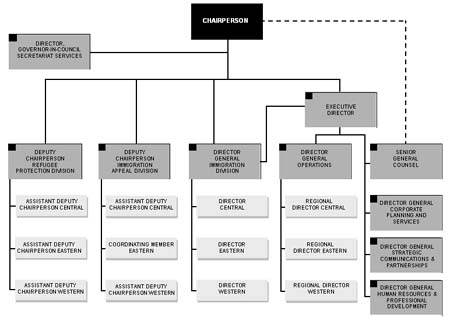
(Click on image to enlarge)
Chairperson
The Chairperson is the IRB's Chief Executive Officer, senior decision-maker and spokesperson. Providing overall leadership and direction to the Board's three decision-making divisions, the Chairperson is responsible for creating and promoting a vision of the IRB that unifies all IRB personnel around the common purpose of making timely and just decisions on immigration and refugee matters.
In addition to the broad responsibility of the management of Governor-in-Council appointees, the Chairperson has a range of statutory powers at his disposal to provide assistance to decision-makers in order to enhance the quality, consistency and efficiency of decision-making. The Chairperson is accountable to Parliament and reports to it through the Minister of Citizenship and Immigration.
Executive Director
The position of Executive Director has remained vacant pending the review of the roles and responsibilities of senior managers at the IRB. Following the report's recommendations, the Executive Director's work description will be reviewed during the next reporting period in order to clarify its relationship with the Chairperson and the division heads. The IRB plans on staffing the position following this revision.
Senior Management
Two Deputy Chairpersons (appointed by the Governor-in-Council) and one Director General (appointed under the Public Service Employment Act) oversee the decision-making in the three divisions. Four Directors General and a Senior General Counsel (all appointed under the Public Service Employment Act) are responsible for the corporate management and services functions, operations of the IRB and legal services.
IAD Innovation
In response to a growing inventory of immigration appeals, the IRB launched the IAD Innovation initiative in late 2005, to comprehensively re-examine all the processes by which IAD appeals are resolved. Following extensive internal and external consultations, the Chairperson released the IAD Innovation Plan in March 2006. The IAD Innovation Plan sought to transform the IAD into a more proactive and flexible tribunal that maximizes the opportunities for parties to resolve appeals within the shortest possible time.
The basic direction is to create a more proactive tribunal by introducing:
- more information earlier from the parties
- more effective case management and triage (screening and streaming of cases)
- early informal resolution
- a more proactive hearing - more focused and efficient
During the 2007-2008 reporting period, the IAD has continued to make changes in conformity with the principles and ideas generated through the IAD Innovation initiative. Public service emloyees at the Board assumed responsibility for the alternative dispute resolution (ADR) program, to free up more decision-makers for hearings. The adjudicative support for the IAD included a comprehensive triage process to effectively screen and stream all appeals. The IAD began to develop enhanced hearing readiness procedures to reduce postponements and adjournments and to facilitate more proactive hearings.
Two pilot projects were completed and continued:
- The CBSA agreeing to appear through written submissions (rather than in person) in residency obligation appeal hearings (Eastern and Central Regions)
- ID-IAD streamlining project – to facilitate the person concerned waiving the right to an oral admissibility hearing and entering into a joint recommendation for a stay of their removal order by the IAD (Central Region)
We continued to develop adjudication strategies to deal with caseload and legal issues in a strategic and consistent manner. The focus was on proactive hearings, where the decision-maker is more involved in managing the hearing to ensure that it is focused on the key issues. Implementation included the development of training materials, several professional development sessions for decision-makers and discussion on best practices.
Integration of Adjudicative Support
To respond more effectively to changes in its volume of work, the IRB has taken two important measures that have had the effect of transforming the way we carry out our mandate. The first has been to thoroughly review how the work is done. With respect to refugee claims, the Chairperson's Action Plan produced significant results through a review of business processes. A similar exercise took place in the IAD, with the Innovation initiative. The second measure that the Board has taken has been to promote functional integration of the three divisions, subject to legal and practical constraints. This has entailed training some decision-makers to hear cases in more than one division.
A major component of functional integration has been to expand the level of adjudicative support to the decision-making process across all three divisions. The integration of adjudicative support is aimed at improving quality and consistency through effective pre-hearing preparation and resolution of cases, as well as enhancing efficiency by enabling decision-makers to focus on their adjudicative functions with the assurance that they are receiving the best available information to make their decisions. Finally, an integrated approach to tribunal support is consistent with the core values of flexibility and responsiveness to business needs that are key components of public service modernization.
On April 1, 2007, a restructuring of public service adjudicative support ensured that the three divisions were supported effectively. The existing community of Refugee Protection Officers (RPOs), Operations Service Managers (OSMs), Quality Project Officers (QPOs) and Regional Program Analysts (RPAs) were amalgamated to include tribunal officers and the mandates for OSMs, QPOs and RPAs were expanded to serve all three divisions. The tribunal officers received training in areas of immigration and refugee law. In addition to accessing employment at a higher classification level, RPOs saw career advancement possibilities expand with new competencies in hand. The Board is benefiting from new efficiencies and flexibility when assigning adjudicative support resources to various functions. The new structure places special emphasis on quality control and enhanced management to assure that the highest quality support is provided to the divisions, enhancing their productivity and the quality of their work.
Impact
The Board's accomplishment of its mandate to make well-reasoned decisions on immigration and refugee matters quickly, simply and fairly is facilitated by the availability of high-calibre adjudicative support. The integration of adjudicative support is contributing to the Board's capacity to resolve as many matters as possible without a hearing, to assure that all matters going to hearing are fully hearing-ready, and to assure that all decisions produced are of the highest quality.
Tribunal officers have developed expertise in the IAD that has helped them to be more creative in their approach to resolve more appeals. By the end of 2007-2008 all cases streamed into the Alternative Dispute Resolution (ADR) mechanism were conducted by trained tribunal officers. The national resolution rate at ADR for the last year is 48%.
In March 2008, only 52% of appeals in the IAD were resolved by a hearing. The remainder of appeals were resolved through ADR or in chambers following receipt of submissions from the parties in response to Early Resolution letters or Early Informal Resolution letters or as the result of the case being declared abandoned or the appellant withdrawing his or her appeal.
Information and Contacts
Legislation Administered
Immigration and Refugee Protection Act
(S.C. 2001, c. 27, as amended)
Immigration and Refugee Protection Regulations
(SOR/2002-227, as amended)
Refugee Protection Division Rules
(SOR/2002-228)
Immigration Division Rules
(SOR/2002-229)
Immigration Appeal Division Rules
(SOR/2002-230)
Oath or Solemn Affirmation of Office Rules
(Immigration and Refugee Board of Canada)
(SOR/2002-231)
IRB Processes
Visit these links to find out how the IRB processes its cases:
- Process for Making a Claim for Refugee Protection
http://www.irb-cisr.gc.ca/en/references/procedures/processes/rpd/rpdp_e.htm - Admissibility Hearing Process
http://www.irb-cisr.gc.ca/en/references/procedures/processes/id/ahp_e.htm - Detention Review Process
http://www.irb-cisr.gc.ca/en/references/procedures/processes/id/drp_e.htm - Sponsorship Appeal Process
http://www.irb-cisr.gc.ca/en/references/procedures/processes/iad/sap_e.htm - Removal Order Appeal Process
http://www.irb-cisr.gc.ca/en/references/procedures/processes/iad/roap_e.htm - Residency Obligation Appeal Process
http://www.irb-cisr.gc.ca/en/references/procedures/processes/iad/resoap_e.htm
Related Information
UNHCR Web site: http://www.unhcr.org/home.html
Contact us
For more information, visit the IRB Web site at
http://www.irb-cisr.gc.ca
or contact the IRB Communications Directorate at 613-947-0803 or one of the IRB offices listed below.
National Headquarters
Immigration and Refugee Board of Canada
Minto Place, Canada Building
344 Slater Street, 12th Floor
Ottawa, Ontario K1A 0K1
Tel: 613-995-6486 Fax: 613-943-1550
Regional Offices
Eastern Region
200 René Lévesque Boulevard West
Guy Favreau Complex
East Tower, Room 102
Montreal, Quebec H2Z 1X4
Tel: 514-283-7733 Fax: 514-283-0164
Central Region
74 Victoria Street, Suite 400
Toronto, Ontario M5C 3C7
Tel: 416-954-1000 Fax: 416-954-1165
Western Region
Library Square, Suite 1600
300 West Georgia Street
Vancouver, British Columbia V6B 6C9
Tel: 604-666-5946 Fax: 604-666-3043